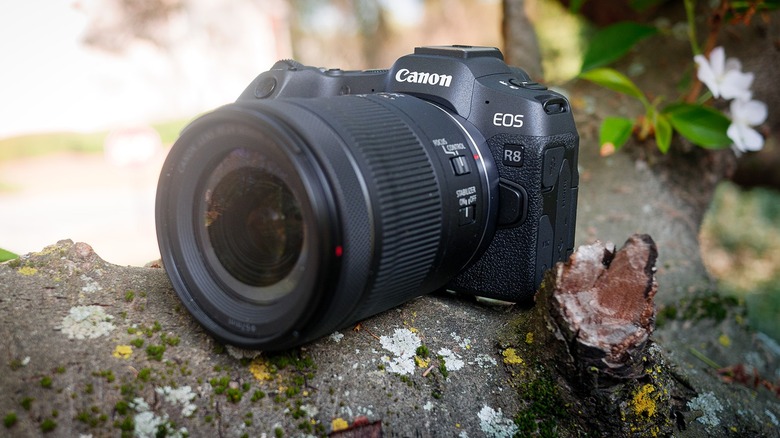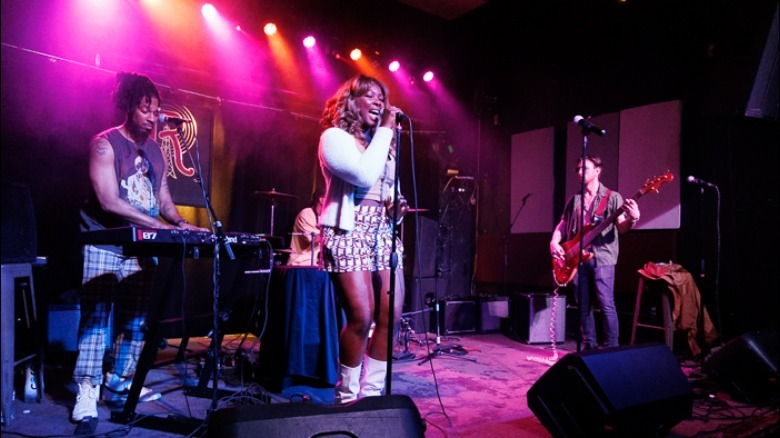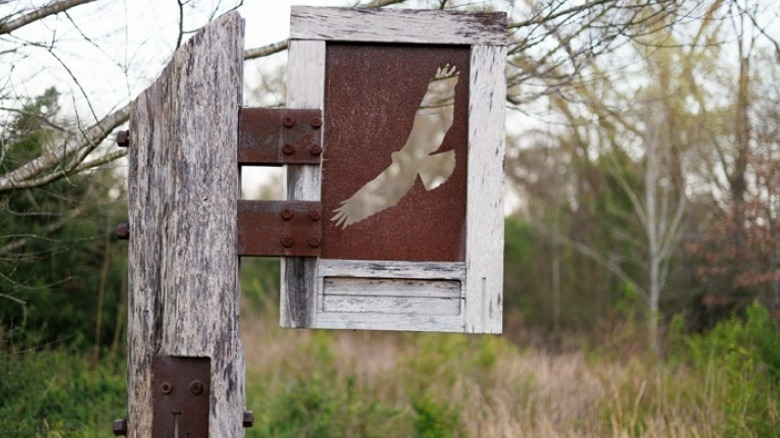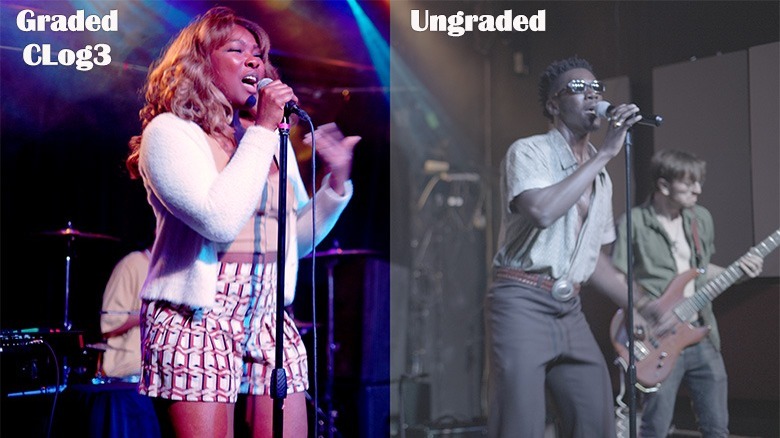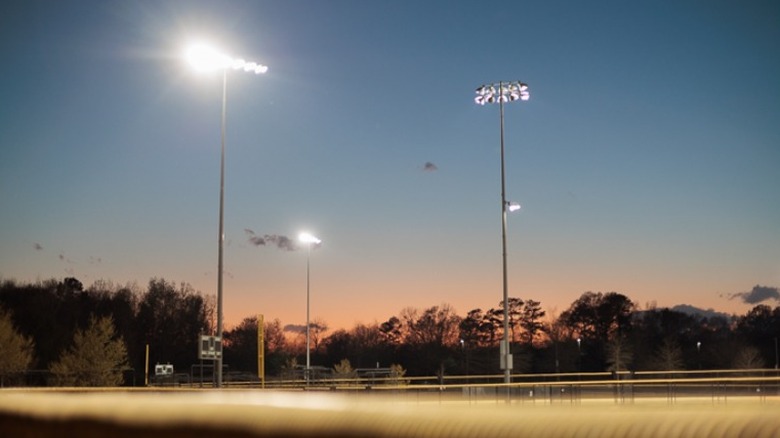Canon EOS R8 Review: Budget Full Frame Power With Compromises
- High Performance at a Low Price
- Fantastic Low Light Images
- Full Frame 4K60 Footage
- Cheap Construction
- Lacking in Physical Controls
- Overheats at Highest Video Settings
We may receive a commission on purchases made from links.
This month, the Canon EOS R8 joins the increasingly crowded market of entry-level full-frame mirrorless systems. At $1,500 it undercuts the price of the Lumix S5-II I reviewed recently – and that camera was already a decent value. In order to deliver this camera at this price, Canon has perhaps had to cut corners in some areas.
For instance, the R8 contains only one SD card slot which is right next to the battery. Those are things that pro photographers bemoan because they can't record duplicate cards for redundancy and they can't swap out the card while the body is mounted on a tripod.
Although it's a brand-new camera, the R8 under the hood is nothing new. It's essentially a parts bin project, taking the pro-grade 24-megapixel sensor out of the R6-II and shoving it into the lightweight consumer body of the Canon RP.
It's like the Shelby Cobra of cameras: Powerful engine in an itty-bitty frame. This approach has surely saved Canon a bundle in development costs — which seem to have been reflected in the device's final price — but it also comes with quirks that a newly designed body would not have.
Canon provided a loaner EOS R8 for the purpose of this review. Aside from the product photos of the Canon EOS R8, all photos in this review were captured with the Canon EOS R8 for this review.
Ergonomics & Handling
Unfortunately, the first thing you notice picking up the R8 is its plastic construction. It straddles all around the camera's aluminum frame, making the lens mount the only bit of external metal on the body. I'm skeptical that this construction will hold up to as many bumps and scratches as the magnesium shells found on many other full-frame systems. The RF lens mount itself does feel plenty sturdy, so no worries there.
The body is especially thin and compact, even compared to other mirrorless cameras. With the lens off, it's almost pocket-able. And with the 50mm prime mounted, it goes snugly into my small shoulder bag. The R8 with battery weighs almost exactly one pound, so it could be great for light travel packing. Despite its thin, compact dimensions, the hand grip still feels very substantial. The adjustment dials are also well-placed for my fingers: something that the small Sony cameras never get quite right.
One of my biggest gripes about the R8 is its distinct lack of certain physical controls, like an EV button, ISO button, manual focus switch, or drive mode selector. The rear click wheel around the directional pad, which has been a long-time Canon staple, is also gone. With these things missing, things that should take one second to accomplish now take several seconds of digging through sub-menus, and those seconds could mean losing a perfect shot. Those things really separate it from more upscale cameras like the R6 or the Panasonic S5.
Display & Menus
With so few physical controls, you have to rely on the touchscreen a lot in the R8. Luckily, it's very accurate and responsive. Image detail and contrast are also quite good, with 1.62 million pixels of resolution. The screen also articulates 180 degrees for selfies and vlogging using the typical plastic hinge.
The electronic 2.36 million dots in the electronic viewfinder also sound impressive on paper, but that's nearly 30% less than the Lumix S5-II viewfinder, as well as the EOS R6-II. Peering through the EVF, I always found that images looked just a little bit muddy, which encouraged me instead to rely on the rear screen.
I've yet to find a modern camera menu system that I really love, and this R8 has not changed my mind. There are so many options and so little organization, so you'll frequently forget which sub-menu a specific feature is on and waste scrolling through it all. It becomes doubly frustrating when you have to open up this menu to do simple things like turning on manual focus. Luckily, there is a custom-assignable folder to alleviate this somewhat.
One thing I do appreciate about this menu system is that it has little tutorials that can pop up when you switch modes, helping to explain things like aperture priority to novice users. I find that really valuable since most cameras don't bother to teach the user anything. If you're already a pro, you can of course turn the pop-ups off.
Autofocus & High Speed Shooting
Like the rest of the RF line, this R8 uses the "Dual Pixel" AF system, which is among the best in the business. The continuous autofocus, called "Servo AF" in the menu, has discrete modes for tracking humans, eyes, animals, and vehicles. In brightly lit conditions, these modes are all very reliable, and they work decently well in low light.
Still, I found that dark-skinned subjects against a dark background would trip the system up, as well as subjects with hair covering up parts of their face. Sometimes the image would appear sharp on my screen, but then be just out of focus by the time the shutter actually closed.
In burst mode, the R8 can also do six frames per second with the mechanical shutter, that's considered slow for a pro camera these days, but plenty fast enough for most photographers in this price bracket. Switch to electronic shutter mode and you also get 30 frames per second raw recording, and 40 FPS Jpeg only. I mostly shy away from electronic bursts, but this sensor shows a surprising lack of rolling shutter artifacts. You could likely get away with shooting sports on electronic mode without issue.
Low Light Images
Without a doubt, this R8 sensor delivers the cleanest high-ISO images I've ever taken. It's practically night vision. Settings go from a base of 100 to a staggering 204,800, and you can reliably use most of that range without ruining images. At 25,600 ISO, images are still sharp enough to make out fine details and noise is very well controlled. At this level, you can easily capture landscapes as the sun dips down, or freeze motion completely in a dimly lit concert venue.
In a pinch, you can even get useable photos at up to 102,400 ISO. They're noisy, but not total mush. It's only when you step up to the maximum setting that you start to see things like heavy color degradation. Noise is more apparent in video mode, but the R8 still puts out reasonably clean footage up to about 8,000 ISO. Get some auxiliary lighting and you should never really be concerned about going that high with the sensitivity. It's only while shooting in the CLog profile that noise really starts to creep into the video. So you'll want to stay away from it in underexposed scenes. The minimum ISO while shooting log video has also been raised to 800.
Dynamic Range & Raw Recording
While technically this camera has a dynamic range that ranks among the best systems ever made, I found that these raw files are retaining much more shadow detail than highlights. Overexposure is best avoided, and the live histogram helps in EV adjustment.
The display also has a "zebra pattern" function which quickly paints overexposed areas of the image. That's one of my most reliable tools to expose a photo, but for some reason, the zebras are available in video mode and not in photo mode. For a more extreme dynamic range, you can also do HDR image stacking inside the camera, giving you one composite image. The results, however, are not pretty. You'll need to adjust photo contrast in post to actually get a natural-looking image.
Like most of the current Canon lineup, the R8 also has access to the CRaw format in addition to standard raws. CRaw uses what they claim to be lossless compression, and nearly halves the file size of a single raw image. Over the long term, that can really save you money on hard drive storage. Also, If there is any image degradation at all happening during the compression, it is not visible to my eyes.
Video Capabilities
That fast sensor readout in electronic shutter mode will also help give the R8 a leg up in video mode since that is an issue a lot of other full-frame cameras struggle with. No rolling shutter makes the R8 great for handheld footage, although the lack of body stabilization does hurt that prospect. The RF kit lenses provided did come with optical stabilization, and they did a decent job of smoothing out any bumps you would while handheld vlogging.
Most high-resolution full-frame sensors will also require a mandatory crop at the highest video settings, but the R8 is able to record true full-frame dimensions at 4K60, and up to 180 FPS in HD. That's a great value add against more expensive competitors like the S5-II. Face tracking is also quite reliable in video mode, even while the subject is mildly backlit. The internal mic also adjusts volume well without getting blown out in loud settings. These things mean that most anybody can pick up the R8 and get decent-looking footage out of it without hours of training.
There's also a dedicated switch to flip the camera over from photo to video mode. This allows you to easily save custom settings for video mode, and have completely different customization available in photo mode. Audio can be piped in with a 3.5mm mic input. Video can be sent to a monitor using a micro HDMI port, but every pro videographer will moan about the lack of full-size HDMI.
Potential Overheating Issues
Ever since the first release of the EOS R line, people have been making noise online about the cameras overheating at high video settings. It's because the bodies are so thin: the image sensor and processor are stacked on top of each other, just trading heat, and that makes sustained recording difficult. The R8 even has a warning label underneath the flip-out screen telling the user not to touch that area due to burning risk. Video recording time is capped at two hours. That's a pretty long time, but perhaps not long enough for serious event videographers.
To feel the burn myself, I ran the R8 continuously at various settings: first at 1080P, then 4K24, and 4K60. In regular old HD, the camera is not breaking a sweat. It breezed through the full two hours and did not feel any warmer. Hit the record button again, and it would probably do another two hours without fail. However, things really heated up when I switched over to 4K24.
Immediately in 4K, a warning pops up telling you that your recording might get interrupted, and a temperature gauge sits in the corner of the screen to show you how close the R8 is to meltdown. During recording, I naturally had to touch the area that the sticker told me not to touch. The body was noticeably warm, but not enough to actually burn your hand. A lot of heat also radiated from the sensor into the metal lens mount.
Overheating at 4K60
The Canon R8 ran for about 98 minutes, with the temperature gauge way in the red, before cutting off. It didn't actually stop because of overheating, but because it filled up the single 128 Gigabyte card. I'd put it up to a coin flip whether or not the camera could endure the full two hours, but I know for sure that it will last a reasonable amount of time while 4K vlogging in a lukewarm room.
Things, however, are not so reasonable at 4K60. With all maxed-out settings, the R8 would only run for 22 minutes before pinning the thermometer and shutting itself down. On paper that sounds pretty bad, but in the real world, it's not actually a big deal. I only ever use 60 FPS to record short slow-mo shots, delivering the final video at 24 or 30 FPS.
This is probably not the video camera for you if you're filming long events, especially since you can't swap cards and batteries easily on a tripod. It's definitely not built for extremely hot environments, and it probably won't handle being hooked up to a 24-hour live stream. For the rest of us, it'll work just fine.
Picture Profiles
The profile options of the R8 are another area I feel is lackluster. Very basic stuff like standard, portrait, landscape, and monochrome, and no real creative options. There are people that will only swear by Canon's color science, but I don't think I like the application in this system. Skin tones always seem to be a little washed out and sickly. When backed up by the sky, they'll inherit an unpleasant blue tone. The monochrome profile also lacks the punchy contrast that I tend to want out of black-and-white photos. You can adjust these things in-camera, but not by much. These things all make me reluctant to just pull Jpegs and post them without editing.
There are also the CLog3 and HDR PQ profiles, which are actually cordoned off in their own menu. CLog is exclusive to video and gives you 10-bit footage with a higher dynamic range, but it requires post-processing in an editor like Adobe Premiere. HDR PQ creates both HEIF photos and 10-bit video that are optimized for delivery to HDR displays.
It's worth noting that the R8 only has access to 10-bit color depth while shooting footage in either CLog or HDR PQ. Any of the other profiles will record standard 8-bit video, which doesn't hold up so well to color and exposure editing.
App Control
The Canon app needs both Wi-Fi and Bluetooth receivers to get your phone talking to the R8, and the connection is fairly quick and reliable. While connected, you can transfer Jpegs to your camera roll and activate remote shooting.
While doing remote shooting on the app, users have access to most of the quick settings that they would have access to with the R8 in their hand. Shutter, aperture, ISO, white balance, and profiles can all be changed on the fly. The only real focus assist available is to touch-select your subject on the app's preview screen, and this works reliably enough.
One hang-up about remote shooting on the app is that the preview image is much lower resolution than what you get on the rear monitor. The whole image is muddy, making it basically impossible to check focus accurately. Still, if you put faith in the R8's AF, it will generally deliver sharp results on the full-res image.
Lens Options
My Canon R8 loaner came with the standard kit lens, a 24-50mm f4.5-6.3, a 24-105 f4-7.1, and a 50mm f1.8. The 24-50 bundles with R8 for $200 extra, while the 24-105 retails for about $400. The 50mm prime comes in at a cheap $180.
If you step up from a crop sensor camera, lenses will be compatible, but they won't be able to use the full image area of the R8. There's not much point in upgrading to full frame if you're forced to crop, anyway. With an EF to RF adapter, you can also make the full suite of Canon DSLR lenses compatible, with full metering and autofocus.
On my S5-II review, I commended that camera system for matching the filter thread sizes on its lenses. Canon has not done that– all three lenses are different sizes. The thread on the prime lens is also 43mm, which is oddly small and doesn't match any of my filters. This is another small thing that could discourage pros from adopting the R series.
Lens Features
The two zoom lenses I tested have snappy, quiet focus motors, while the 50mm was a little bit slow and clunky. It feels like a more dated design. All RF lenses use electronic focus control. While AF is active, you can also customize this ring to adjust features like exposure compensation and ISO. It's a neat addition. The manual focus curve can also be set to linear mode in order to mimic an analog focus ring.
Instead of getting the standard kit lens, you may want to drop a couple hundred bucks extra and opt for the 24-105mm. You'll get a wider zoom range, plus slightly better F-stop performance. Both lenses are stabilized as well, which will make them ideal for handheld vlogging. I generally avoid variable aperture lenses, but the incredible noise performance on this R8 sensor makes narrow apertures less of an issue.
With MF active, the R8 also gives you a handy focus guide that's similar to the phase detect icon in older SLRs. I find this guide much more reliable than the contrast-based focus peaking that most other mirrorless cameras have to rely on. However, the focus guide icon does not pop up when using adapted manual lenses, which limits its total usefulness.
Who is the EOS R8 For?
The R8 has probably the most advanced image sensor I've ever put in my hands, but the lack of physical switches and mandatory menu-digging made me not want to use it so much. I think anyone looking to trade in a pro-DSLR like a 5D Mk. IV will feel similarly. They're going to gravitate more to the R5 or R6. However, stepping up from something like a Canon Rebel or M50 will have you blown away by its capabilities.
I think this camera will be for amateur photographers and vloggers that are on a tight budget but want to step up to full-frame capabilities. That's a tight niche, considering that the R8 is still several times more expensive than the cheapest crop sensor cameras. On the other hand, it may be incredibly popular with astrophotographers thanks to its best-in-class nighttime capabilities. Also, the R8 could be useful for pros looking for a secondary or travel body that's not as expensive as their primary one.
If you're a vlogger, and you just shoot with the stabilized kit lens in auto mode, you will get reasonably good footage. However, you won't be using anywhere near the full capabilities of the R8. I'd encourage you to pick up a fast prime lens and really learn the settings that are available. You paid for the whole camera, after all.
Pricing and Availibility
The Canon EOS R8 releases on April 18, with preorders open now. Body-only is approximately $1,500 – or closer to $1,700 with the kit lens. That's well worth the value, but still more expensive than the EOS RP, which is currently available for around $1,000.
At $1,500, the R8 basically has no peers, but if you step up to the $2,000 range you can find plenty of options with better construction and ergonomics. Take the Sony A7 IV, which comes with a sturdy metal body and more physical controls. The recent Lumix S5-II also packs in more pro-friendly features. While the S5-II requires a crop during 4K60 recording, it also has a built-in fan to eliminate the overheating issue.
I feel very conflicted about the Canon R8. In a lot of ways, it's the most advanced camera system that I've ever handled, but it also has a lot of little things missing that make it kind of a chore to use. It's definitely something positioned to win over people that are upgrading from cheaper bodies, but it won't pull in high-end buyers.
